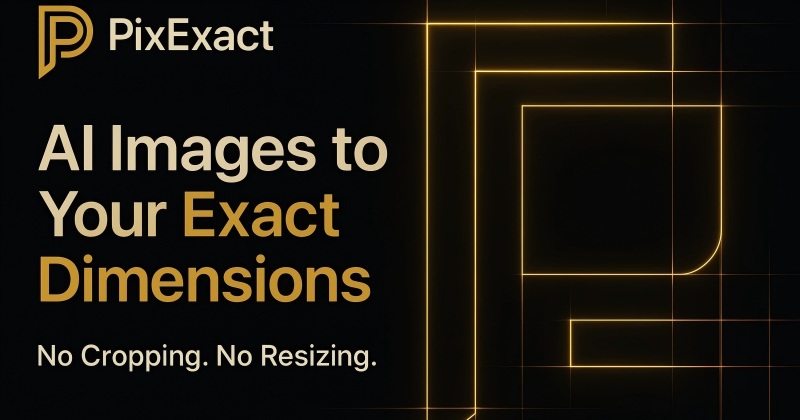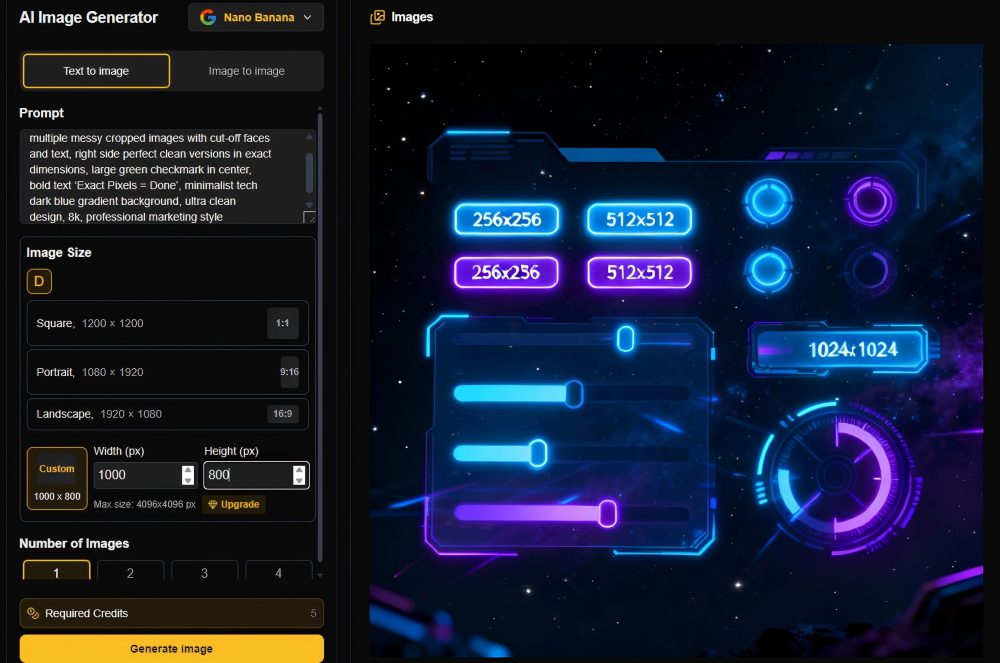Generating a "specific size" image means producing a canvas with an exact pixel width and height (for example, 1200x628 or 3840x2160), not merely matching an aspect ratio that still requires cropping or resizing later.
PixExact lets users enter precise width and height up to 4096x4096, ensuring the exported file already meets target specs without additional edits.

Why you need exact-size images
When a platform or placement specifies pixel dimensions, matching the exact width and height ensures your image is accepted, renders crisply, and avoids auto-cropping that can cut off key content.
YouTube thumbnails are a classic example: using a 1280x720 canvas preserves clarity across devices and helps your thumbnail remain legible in feeds and search results.
E-commerce marketplaces often recommend at least 1000x1000 and commonly 2000x2000 so that zoom and detail views look sharp without artifacts introduced by later upscaling.
For websites, outputting hero and banner assets at target canvases like 1920x600 or 1920x1080 reduces browser resampling and CSS stretching, which protects type edges, brand marks, and fine UI details.
Designing directly at the target pixel matrix also stabilizes composition, because you place focal points, safe areas, and text where they will live in the final UI rather than hoping a later crop lands perfectly.
This matters most for high-stakes placements—ads, thumbnails, and first-screen hero images—where a few pixels can decide legibility, click-through, and brand perception.
The usual way: generate first, fix later
A common workflow is to generate an image at a convenient ratio or a default resolution, then crop, extend, or resize it in an editor to meet the required pixels, which introduces extra steps and potential quality loss.
Traditional editors can hit precise dimensions via Image Size or constrained crop, but when the gap between the original and the target canvas is large, you risk blur or compression artifacts unless you add another pass of super-resolution.
“Generative expand” techniques in tools like Photoshop can adapt a composition to a new canvas with AI fill, yet this remains a multi-stage pipeline that is relatively slow and sensitive to operator skill and iteration time.
Many AI generators focus on aspect ratios and internal upscalers, which often means starting at a default size such as ~1024 and upscaling to ~2048, then relying on external tools to hit arbitrary pixel targets.
Even with flexible UIs like Stable Diffusion front-ends, pushing to very high pixels may require adjusting UI limits and VRAM strategies, increasing complexity for non-technical users and slowing teams that need fast, repeatable outputs.
The best way now: generate exact pixels with PixExact
The most efficient approach is to set the exact width and height before you generate, so the model composes within the final canvas and the export is immediately production-ready with no additional cropping or upscaling.
PixExact supports both Text-to-Image and Image-to-Image: enter your prompt or upload a reference, set precise dimensions up to 4096x4096, generate, and download a file that already meets your target specs.
Because PixExact composes into the destination canvas, you protect focal points and framing, avoiding awkward cut-offs that often happen when an image is retrofitted to a different pixel map after the fact.
Downloads are watermark-free and include a commercial license across plans, which allows teams to move from idea to deployable creative without switching tools or negotiating file rights mid-workflow.
For non-technical marketers and designers, this single-step canvas targeting is simpler than managing ratio prompts, chained upscalers, and manual crops, especially under deadlines and when producing multiple aspect variants.
If you ever need a different layout, you can simply generate again at the alternate pixel canvas rather than force-scaling a single master and risking degraded text and logos.
How to Generate Specific Size Image in PixExact
Text to Image
Describe what you need, set exact width and height (for example, 1200x628 or 1080x1920), generate, and export an asset aligned with your ad or web specs in one step.

Image to Image
Upload your base image, choose the target canvas, and generate a version that fits the frame, keeping the main subject and composition intact while matching production pixels.

For ads and banners, plan your copy, logo, and CTA placement during generation so they sit within expected safe areas for each platform, minimizing UI overlap and review failures.
Common platforms: exact sizes and ratios
| Platform / Use Case | Recommended Exact Pixels | Aspect Ratio | Notes |
|---|---|---|---|
| YouTube Thumbnail | 1280x720 | 16:9 | Minimum, looks sharp on 4K TVs |
| YouTube Channel Art / Banner | 2560x1440 | 16:9 | Safe area 1546x423 |
| Google Display Ads (most used) | 300x250 / 336x280 / 728x90 / 970x250 / 300x600 | various | Cover 90%+ of GDN inventory |
| Meta – Square Post | 1080x1080 | 1:1 | |
| Meta – Vertical Post | 1440x1800 | 4:5 | |
| Meta – Stories / Reels | 1080x1920 | 9:16 | Full-screen mobile |
| LinkedIn Single Image Ad | 1200x628 | 1.91:1 | Also used as default share image |
| LinkedIn Square | 1200x1200 | 1:1 | |
| LinkedIn Vertical | 720x900 | 4:5 | |
| E-commerce Product (Amazon, Shopify) | 2000x2000 (or higher) | 1:1 | Zoom-ready |
| Website Hero / Full-width Banner | 1920x1080 or 1920x600 | 16:9 / ~3:1 | Covers Retina and standard displays |
Composition and QA tips for fixed canvases
For 9:16 canvases like Stories/Reels, keep key subject matter and copy inside center-weighted safe zones so overlays and controls don't occlude CTAs or product details.
On LinkedIn 1200x628 and 1200x1200, pre-check contrast and font sizes for both desktop and mobile; prioritize simple backgrounds so headlines and logos remain readable at small preview scales.
For GDN's smallest slots, validate typography at 300x250 and 320x50 first; once legible at the smallest size, scale the creative to larger canvases to minimize rework.
If you must adjust an already generated asset, prefer light edits at the same pixel canvas rather than resampling to a new size, and only use high-quality interpolation if direct regeneration at target pixels is not an option.
Why exact pixels beat ratio-only workflows
Aspect ratio describes shape but not the number of pixels, which is why ratio-only outputs still require resizing that can blur edges or upset carefully crafted layouts.
Some AI tools emphasize ratio prompts and capped upscalers, which is efficient for exploration but less reliable when your deliverable must be an exact pixel file for ads, UIs, or app stores.
Direct exact-pixel generation eliminates chained steps and preserves fidelity, saving time and protecting composition so teams can focus on message and testing rather than file gymnastics.
The PixExact advantage in practice
PixExact's ability to generate directly to 4096x4096 supports 4K-class canvases, large displays, and high-detail square assets without relying on external upscalers or multi-tool pipelines.
Because both Text-to-Image and Image-to-Image honor your target width and height, you can standardize a template library for ads, thumbnails, heroes, and product images and reproduce layouts consistently.
With watermark-free downloads and commercial usage rights across plans, you can move fast from idea to campaign while keeping legal and brand needs aligned in a single tool.
Generate exact-pixel images right now
Do it the right way: open PixExact right now, set your exact width x height (1280x720, 1200x628, 4096x4096 – whatever you actually need), and download a production-ready image in one click – no cropping, no resizing, no second tool.
